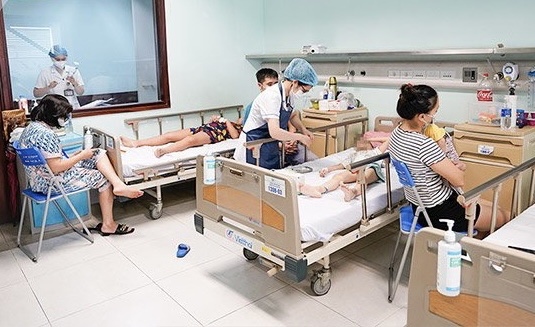Vietnam sees seven deaths amid rising Adenovirus infections
VOV.VN - The National Children's Hospital in Hanoi has so far this year recorded as many as 1,406 Adenovirus infections in children including seven deaths, reported the hospital on September 22.

Notably, a total of 1,316 infections had been detected at the hospital from August 1 to September 21 alone.
Since the beginning of this year the Adenovirus has been detected in 1,406 children, with 811 being treated at hospital and seven adenovirus-associated deaths being recorded, according to figures released by the National Children's Hospital on September 22.
Amid a rising number of patients infected with the virus the hospital is making every effort to detect early signs and symptoms of suspected Adenovirus in children who visit for health examinations.
The hospital has arranged 300 beds for the treatment of pediatric patients who are hospitalised with mild diseases, diseases relating to respiratory damage, or those who suffer underlying diseases and severe comorbidities.
According to Assoc. Prof. & Dr. Le Thi Hong Hanh, director of the hospital’s Respiratory Centre, Adenovirus is divided into seven groups from A to G, of which there are more than 50 types causing diseases to hit different organs.
The most common illnesses caused by the Adenovirus infection are upper and lower respiratory tract infections, eye conjunctivitis or pinkeye, gastrointestinal diseases such as diarrhea, vomiting, and nausea, cystitis, encephalitis, and meningitis, the doctor said.
The diseases caused by Adenovirus appear throughout the year, although they especially thrive at the time of seasonal change.
Adenovirus is transmitted via droplets of respiratory transmission between people. It is also possible for the disease to be transmitted through mucous membranes when swimming or contaminated water used in daily life, or transmitted when healthy people share personal items with sick people.
The incubation period ranges from between eight to 12 days.
Adenovirus can cause illness in all ages, with children between the ages of six months and five years most likely to get sick.
“Adenovirus has the ability to spread quickly in the community and cause many dangerous complications if not treated promptly, such as respiratory failure, sepsis and multi-organ failure,” Hanh said.
“The diseases can also leave long-term complications, affecting the health of children including post-infectious bronchiolitis obliterans syndrome, bronchiectasis and pulmonary fibrosis," the doctor said.
According to information given by medical experts, there is currently no adenovirus vaccine available to infirmaries in Vietnam, meaning the best way to control the spread of the disease is to detect it early.
Moreover, parents should practice preventive measures, including maintaining good hygiene, ensuring a well-ventilated environment, and proper nutrition.

